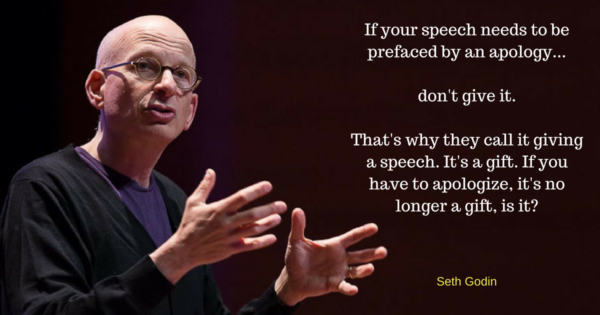According to the Internet and pretty much everyone I know (so it must be true) the fear of public speaking is more widespread and severe than fear of flying, spiders, clowns, and even death.
That’s right: People are less afraid of dying on stage than, umm, dying on stage.
I’ve had three different very smart, very engaging people ask me for public speaking advice in the last month. I’d like to pass it along to you, too. I break down the proverbial 20-minute Rotary or Kiwanis or Chamber talk into seven steps of preparation, but really, it works for lengthier talks, too. If you have any questions, please let me know!
As far as public speaking, (A) you’re a kind, naturally-likable storyteller. You’ll be fine. If I have some general tips, they are as follows:
- Know how long you’re supposed to speak. If it’s the standard 20-minute talk, plan for 18-minutes for two reasons. (A) There might be a couple questions. (B) No one’s ever complained that a speaker ran a little short.
- Ultimately, reverse-engineer it: What is it, really, you want your audience to do if they’re so moved to do so by your speech. Literally, write that down in three simple sentences or fewer. Then, think about how best and how easiest they can do what you want. There. Boom. You have your ending. Always write/prepare the end of any speech first.
- Open with what’s in it for them. You’ve only got a couple minutes to grab them before they start thinking about the rest of their day while politely pretending to listen. So talk about THEM. How and why does this affect them? To what emotion of theirs can you appeal?
- Transition from there to the problem you’re trying to solve. Be specific. What benefits these folks doing whatever it is you want them to do. What obstacles do you face? Win them over by clearly illustrating the problem to which the rest of your speech offers a solution.
- Why is it worth it for them to make the effort? Here’s a great place for one, two, or three supporting stories. Make it personal. Make it real. Raise the stakes for people in your audience. If you use statistics, cite their sources. It gives you credibility.
- Time for your ending – #2. Bring it home clearly and make it easy for them to do what it is you want them to do.
- Be gracious. Make it easy for them to get ahold of you (personally – it gives them a face, not an organization) to follow up.
Practice. Aloud. Not just in your own head. It sounds different when you start speaking aloud and hear your own voice. Use a timer. Shoot for 16 minutes if it’s a 20-minute talk. That’ll give you room to breathe when you’re live. Pauses and looking around the room are your friends. Make eye contact, make a point, then move onto someone else. You’re going to find people who are giving you great non-verbal affirmation (nodding and stuff). Keep going back to them. It’ll give you confidence, and at the end of the day, that’s what any speech is about: Transferring confidence in your beliefs to your audience so they know how and want to take action when you’re done.
Oh, and PS – Awhile back, I asked a whole bunch of experienced public speakers for their best tip. If you want to check them out, I gots 61 of them.

